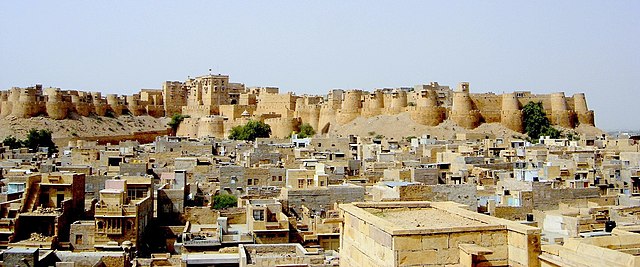Bhati
Rajput clan From Wikipedia, the free encyclopedia
Rajput clan From Wikipedia, the free encyclopedia
Bhati (Hindi: भाटी, romanized: Bhātī) is an ancient warrior clan of Rajputs which claims descent from a common ancestor, Rao Bhatti.[1] The Bhati clan historically ruled over several cities in present-day Pakistan and India, with their final capital and kingdom being Jaisalmer, India. The Punjabi inflection of the word is Bhatti.[2][3]



The Bhatis of Jaisalmer belonged to the Yadava clan of Rajputs.[4] They reportedly originated in Mathura through a common ancestor named Bhatti, who was a descendant of Pradyumn.[5] According to the seventeenth-century Nainsi ri Khyat, the Bhatis after losing Mathura moved to Bhatner in Lakhi Jungle, and from there to other locations in western and northwestern India including Punjab. The Bhati ruler of Tanot, Rao Tannu-ji, utilized his long reign (until 814 AD) to consolidate the Bhatis' expanding strength in western Rajasthan and the eastern Cholistan desert area. He is credited with defeating and destroying the domains of the Varya Rajputs and Langas of Multan. A unified attack against the Tanot Bhatis by the Pathans led by Hussain Shah, together with tribes such as the Langas, Khichis, Khokars (Ghakkars), Johiyas, and others, was successfully driven back under Tannu-ji's leadership.[6]
By the 12th Century, Rohri and Sukkur in the present-day Sindh, Pakistan had been incorporated in dominion of the Bhati Rajputs.[7] Jaisalmer had a dynasty with a successful line of rulers and this became their center. Bhatner, Pugal, Bikrampur, Barsalpur, Deravar, Maroth, Kehror, Aasnikot, Tanot, Lodhruva and Mamanvahan were some of the fortified settlements that were historically ruled by the Bhati clan or subclans. The Bhati ruler Vijayrao Lanjo ruled a large empire, He was known as the 'uttara disi bhad kivaad' (the sentinel of the north direction), due to his control over forts and settlements that extended from Ghazni to Gujarat, leading to several conflicts with the invading Muslim tribes.[2] According to epigraphic evidence, Vijayarao Lanjo took the large title of Parambhattaraka Maharajadhiraja Parameshwara (the paramount sovereign, great king of kings, the supreme reality).[6] He was succeeded by his son, Bhojde in 1143.[8] However, Bhojde's uncle Rawal Jaisal Singh colluded with the Ghaznavid chiefs, and Bhojde was killed in the resulting combat. Following Bhojde's death, Jaisal became the head of Bhatis.[9] The Phulkian dynasty claimed direct descent from Rawal Jaisal Singh, the Bhati Rajput founder of the Kingdom of Jaisalmer.[10] The Rathores, the Balochs, the Dehli Sultans, and eventually the Mughals had all clashed with the Bhati kings.[9] Rao Kelana, a powerful Bhati Rajput ruler of Pugal in the 15th century had expanded his territories up to Bhatinda and Abohar, and was responsible for the death of Rathore ruler Chunda of Marwar. Rao Kelana invaded Dera Ghazi Khan and defeated the Balochs. As part of the peace settlement that followed, Zubeida, the daughter of the Baloch chief Jam Ismail Khan (founder of Dera Ismail Khan), was married to the Bhati ruler.[6]
Sir Alexander Cunningham identified ruins on the site of the Rawalpindi Cantonment in Punjab as the ancient city of Gajipur (or Gajnipur), the capital of the Bhatis in the ages prior to the Christian era.[11] The ancient history of the Bhatis alludes to a tradition in which they claim not only to have erected the fort and city of Gazni in Afghanistan, but also to have settled Sialkot (Salbahnpur), named after their ancestor Salbahan, who conquered the entire Punjab. The Bhatis also claim to be the ancestors of the Chughtai Mughals through an ancestor named Chakito who became the king of Balich and Bokhara. The historian Tanuja Kothiyal notes that a part of such claims may well be justified.[2]
The greeting used by Bhati Rajputs is 'Jai - sri' or 'Jai - sri - Kishan' ( victory to Lord Krishna ) as opposed to the general Rajput greeting 'Jai - mata - jiri' (victory of the Mother Goddess).[12]
Dulla Bhatti was a Punjabi landlord who led a revolt against Akbar.[13] He remains Punjab's folk hero and is made the centrepiece of all Lohri songs.[14]
Seamless Wikipedia browsing. On steroids.
Every time you click a link to Wikipedia, Wiktionary or Wikiquote in your browser's search results, it will show the modern Wikiwand interface.
Wikiwand extension is a five stars, simple, with minimum permission required to keep your browsing private, safe and transparent.